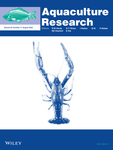Abstract
This study was conducted to examine the supplementary effects of tuna hydrolysate (TH) and shrimp hydrolysate (SH) as squid-liver powder (SLP) replacers in a high soybean meal diet for Pacific white shrimp (Litopenaeus vannamei). A diet containing 4.49% SLP was regarded as the control diet and two other diets were prepared by supplementing 1.14% tuna hydrolysate (TH) and 0.94% shrimp hydrolysate (SH) (designated as SLP, TH and SH, respectively). Five replicate groups of shrimp (initial mean body weight, 0.35 ± 0.002 g) were fed one of the experimental diets for 52 days. Final body weight and weight gain of shrimp fed SH and TH diets were significantly higher than those of shrimp fed SLP diet (p < 0.05). Feed conversion ratio was lower in SH group compared to that of shrimp fed other diets. Total antioxidant capacity and catalase activity were significantly higher in TH or SH group than SLP group (p < 0.05). Hemolymph glucose and triglyceride levels of shrimp fed SLP were significantly lower than those of shrimp fed TH and SH (p < 0.05). Shrimp-fed TH or SH exhibited significantly higher carcass lipid composition than shrimp-fed SLP (p < 0.05). Dry matter and protein digestibility were significantly higher in SH diet (p < 0.05). The findings in this study indicate that SH and TH can be used as beneficial feed supplements or ingredients that could replace SLP in L. vannamei diet. Optimum inclusion level of SH would be approximately 1% to completely replace SLP in L. vannamei diet containing high level of soybean meal.

